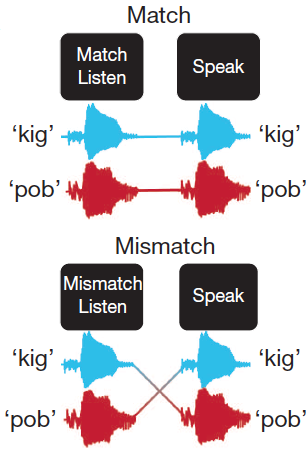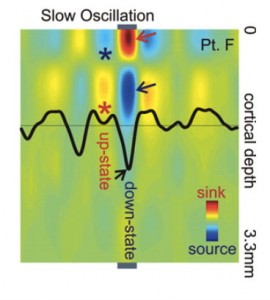
Image from Cogan et al., Sensory-motor transformations for speech occur bilaterally, Nature, 2014.
Image from Cash et al., The human K-Complex represents an isolated cortical down-state, Science, 2009.
NYU ECoG Group
The NYU ECoG Group comprises a diverse group of researchers and clinicians who are dedicated to advancing our understanding of human cognition and improving the health of people with cognitive disorders. Faculty from a number of departments and institutes at New York University, including the Comprehensive Epilepsy Center, Center for Neural Science, Neuroscience Institute, Department of Psychology, Department of Neurosurgery, Department of Neurology, and Department of Electrical and Computer Engineering, are actively involved in this research. In addition, we collaborate with a number of external groups, including researchers and clinicians at the University of California, San Diego, Harvard University, Princeton University and Columbia University. The group is based within the NYU Comprehensive Epilepsy Center (Director: Dr. Orrin Devinsky) and led by Dr. Lucia Melloni, Ph.D., Director of the NYU ECoG Group.
An understanding of how the human brain functions requires methods that enable the activity of neurons and neuronal networks to be recorded in real-time. Electrocorticography (ECoG), or intracranial EEG (iEEG), is the practice of using invasive electrodes, which are implanted inside or on the surface of the brains of patients during clinical procedures, to record electrical activity from the cortex and other brain regions. A clear advantage of ECoG over other methodologies for studying the human brain is that it possesses both high spatial and temporal resolution (mm and ms scales, respectively). Furthermore, it enables direct measurements of neuronal activity; this is in contrast to other methods, such as fMRI, which are limited to surrogate measures of neuronal activity (eg. regional blood flow and metabolic changes), or scalp EEG, which is limited to diffuse electrical signals that make pinpointing their source difficult. Thus, ECoG recordings provide unique opportunities to examine the underlying neural mechanisms and networks involved in a wide-range of cognitive processes in humans, including speech and language, sensory perception, memory, and decision-making.
Since the inception of the NYU ECoG Group in 2007, more than 10 peer-reviewed studies – involving data collected from a large number of patients – have been published. These studies have led to several important insights in the field of cognitive neuroscience, including:
(i) the demonstration that speech transformations occur on both sides of the brain (Cogan et al, Nature, 2014),
(ii) that slow fluctuations of high-frequency power are not noise but reflect the accumulation of information over long timescales (Honey et al, Neuron, 2012),
(iii) the demonstration of a letter-form area within the visual reading system (Thesen et al., Nature Communications, 2012), and
(iiv) that the human K-complex, a defining characteristic of slow-wave sleep, reflects a cortical down-state (Cash et al., Science, 2009).
Such advancements would not have been possible without the generous participation of patients in these studies and the funding agencies (NINDS, NIMH, NIDCD, DoD) and private foundations (FACES) that support this research.

